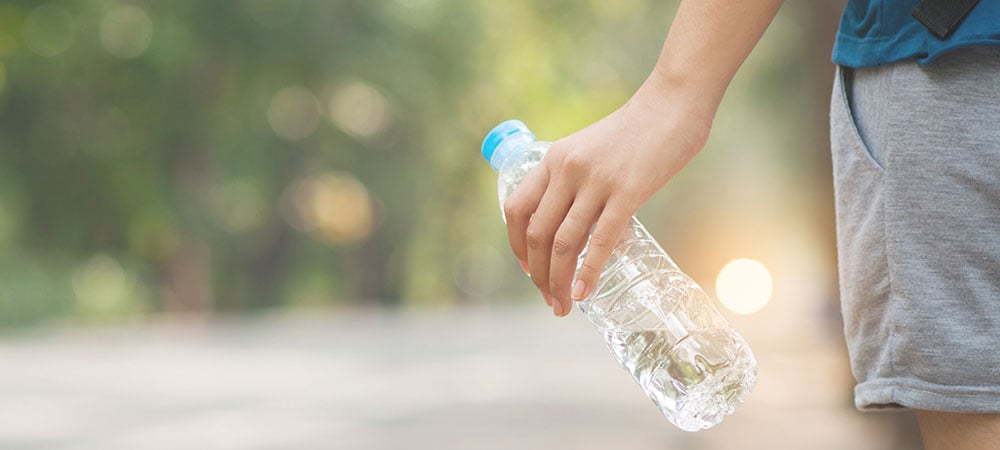
Top 5 reasons to choose filters over bottled water
November 2021
If you’re concerned about contaminants in the tap water you drink every day, you’re not alone. We all deserve to know what we’ll be putting in our bodies when we turn on the tap. This is one of the reasons why EWG created its Tap Water Database in the first place.
But if you want safer water for yourself and your family, bottled water isn’t the solution – not for your pocketbook, not for your health and certainly not for our planet.
Your best option for cleaner, healthier drinking water on the go is filtered tap water and a reusable glass or stainless steel container. As we say here at EWG, know your water, pick the best filter and choose a BPA-free water bottle.
Here are five reasons why you should say no to bottled water and choose filtered instead.
1. The cost
According to the Environmental Protection Agency, tap water costs about $.002 per gallon1 – that's two-tenths of a penny – whereas a liter of water from the cooler in your local convenience store costs about a dollar before tax. That means if you drink bottled water, you’re paying about 2,000 times more for it.
Nonetheless, Americans drank 15 billion gallons of bottled water in 2020, an increase of more than 4 percent over 2019, according to the Beverage Marketing Corporation.2 There are better things you could spend your money on than water in plastic bottles – perhaps even invest in a nice tap water filter.
2. The quality
Laboratory testing by EWG has found all sorts of nasty stuff in popular brands of bottled water – disinfection byproducts, industrial chemicals, prescription drugs and even bacteria. And unlike your local tap water utilities, which are required to test for contaminants each year and disclose the results to the public, the bottled water industry can hide the test results. Knowledge is power, and with bottled water you’ll likely know nothing about what you're drinking.
3. The bottle itself
It’s bad enough that the bottled water you’re drinking might be contaminated. But the bottle itself could be adding to the problem.
An EWG investigation found that PET plastics – the kind used to make plastic water bottles marked with a “1” on the bottom – can contain dozens of chemical additives, manufacturing impurities and breakdown byproducts. That’s more than 80 additional contaminants that could be leaching into your water.
Bottom line: Get a reusable glass or stainless steel bottle, and fill it with filtered tap water.
4. The trash
EPA statistics show that less than 30 percent of PET plastic bottles and jars were recycled in 2018.3 That means the other 70 percent was left to clog landfills, harm wildlife and pollute waterways. In fact, the marine conservation organization Oceana estimates that up to 20 million tons of plastic end up in our oceans each year,4 with some collecting to form huge, free-floating landfills like the Pacific Garbage Patch, which is estimated to be about the size of Texas.5
5. The wasted energy
Trash isn’t the only environmental problem caused by water bottles.
Analysis by the Pacific Institute, a global water think tank, found that bottled water takes up to 2,000 times more energy to produce than tap water.6 It takes energy to make the bottles, fill them with water and ship them to your local convenience store – sometimes over great distances.
In extreme circumstances, bottled water might be the best bet. Residents of Flint, Mich., for example, were forced to rely on bottled water when their tap water was considered unsafe to drink. And natural disasters, such as the hurricanes and wildfires caused by the climate crisis, may make tap water undrinkable. In that type of situation, bottled water is often the only option. But for almost everyone else, filtered tap water is the clear winner.
References
1 Environmental Protection Agency. “Water Facts of Life: Ride the Water Cycle With These Fun Facts.” 2016. Available at www3.epa.gov/safewater/kids/waterfactsoflife.html.
2 Beverage Marketing Corporation. “Press Release: Bottled Water Unbowed by COVID- 19 Crisis, Grows Again in 2020, Data FROM Beverage Marketing Corporation Shows.” 2021. Available at https://www.beveragemarketing.com/news-detail.asp?id=654
3 EPA. “Advancing Sustainable Materials Management: 2018 Fact Sheet.” 2020. Available at https://www.epa.gov/sites/default/files/2021-01/documents/2018_ff_fact_sheet_dec_2020_fnl_508.pdf.
4 Madeleine Simon. “Global Issue of Marine Plastics Is Gathering Significant Media Attention.” Oceana, 2014. Available at usa.oceana.org/blog/global-issue-marine-plastics-gathering-significant-media-attention.
5 Oceana. Pacific Garbage Patch. Available at usa.oceana.org/pacific-garbage-patch
6 P.H. Gleick and H.S. Cooley. “Energy Implications of Bottled Water.” Environmental Research Letters, 2009, 4(1). Available at iopscience.iop.org/article/10.1088/1748-9326/4/1/014009.
